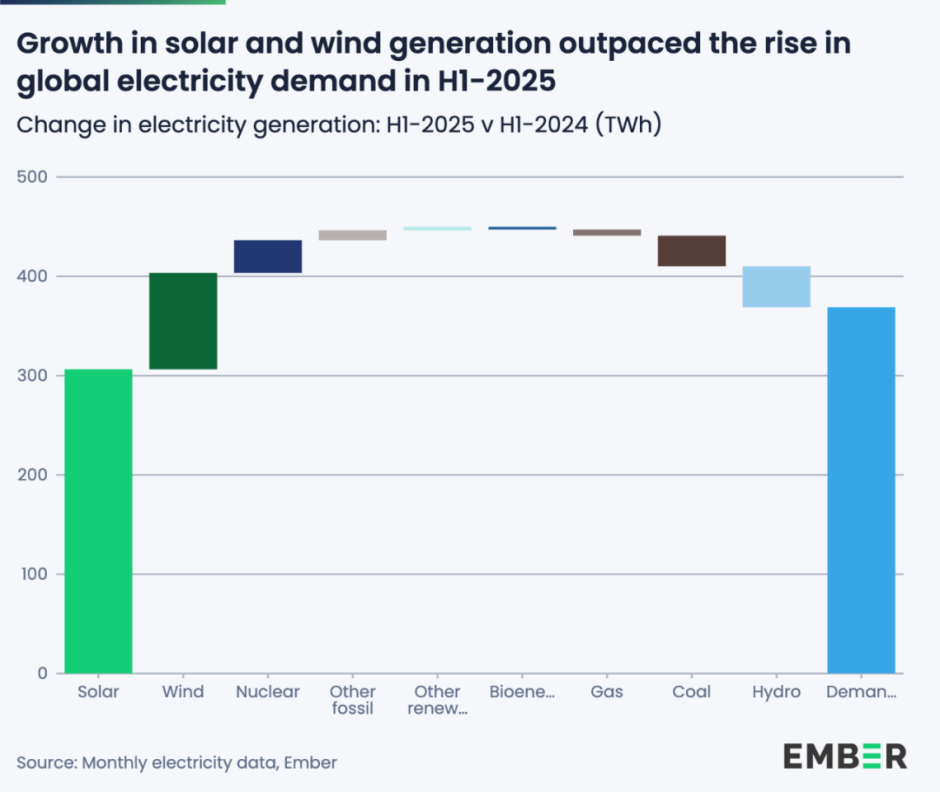Solar and wind energy have officially outpaced the growth in global electricity demand during the first half of 2025, marking a historic shift in the world’s power mix. According to new analysis from Ember, record solar expansion and steady wind growth led renewables to overtake coal for the first time on record, signaling a major turning point in the global energy transition.
“We are seeing the first signs of a crucial turning point,” said Małgorzata Wiatros-Motyka, Senior Electricity Analyst at Ember. “Solar and wind are now growing fast enough to meet the world’s growing appetite for electricity. This marks the beginning of a shift where clean power is keeping pace with demand growth.”
Global electricity demand rose 2.6 percent in the first half of 2025, adding 369 TWh compared to the same period last year. Solar power alone met 83 percent of this growth, contributing a record 306 TWh—a 31 percent year-on-year increase. Combined, solar and wind expanded fast enough to offset fossil fuel generation, resulting in a small but significant decline in both coal and gas use.
Coal generation fell 0.6 percent (-31 TWh) and gas dropped 0.2 percent (-6 TWh), partly offset by minor increases in other fossil sources. Overall, fossil generation declined 0.3 percent (-27 TWh), leading to a 0.2 percent reduction in global power sector emissions.
For the first time, renewable energy generated more power than coal, supplying 5,072 TWh of electricity worldwide—up from 4,709 TWh a year earlier—while coal generation fell to 4,896 TWh. This crossover underscores the accelerating impact of clean energy technologies on global energy systems.
China and India continued to drive the global clean energy transition in the first half of 2025, recording record growth in solar and wind power while cutting fossil fuel use and power sector emissions. In contrast, the US and EU saw an increase in fossil generation as weaker wind and hydro output coincided with rising electricity demand, according to the latest analysis from Ember.
China powers ahead in solar and wind expansion
China remained the world’s clean energy leader, adding more solar and wind generation than the rest of the world combined. In the first half of 2025, China’s solar output surged 43 percent (+168 TWh) and wind rose 16 percent (+79 TWh) compared to the same period last year.
Electricity demand in China increased 4.2 percent (+198 TWh), significantly lower than the 7.5 percent growth recorded a year earlier. This expansion of renewable generation enabled China to reduce coal use by 2 percent (-56 TWh) and gas use by 2 percent (-2.7 TWh). As a result, the country’s power sector emissions fell by 1.7 percent (-47 MtCO2)—a major milestone in decarbonization progress.
India achieves record solar and wind growth
India also achieved record clean power growth, with renewable generation far exceeding demand growth. Electricity demand increased just 1.3 percent (+12 TWh), a sharp slowdown from 9 percent (+98 TWh) in the same period last year due to milder weather and slower industrial output.
India’s solar generation rose 25 percent (+17 TWh) and wind grew 29 percent (+11 TWh), marking the country’s largest-ever expansion in renewable generation. This clean energy surge drove down coal use by 3.1 percent (-22 TWh) and gas by 34 percent (-7.1 TWh), cutting power sector emissions by 3.6 percent (-24 MtCO2).
US and EU fossil generation rise amid weaker renewables
While Asia saw emissions fall, both the United States and the European Union experienced a rebound in fossil fuel generation as renewable output faltered.
In the US, electricity demand rose 3.6 percent (+76 TWh), outpacing growth in solar and wind. Solar generation increased 14 percent (+44 TWh), but wind rose only 2 percent (+5 TWh). As a result, coal generation climbed 17 percent (+51 TWh) while gas fell 3.9 percent (-34 TWh) due to higher prices. Overall, US power sector emissions rose 4.3 percent (+33 MtCO2).
In the EU, electricity demand grew modestly by 0.7 percent (+9 TWh), but weaker renewable performance led to greater fossil reliance. Solar generation rose 12 percent (+37 TWh), while wind and hydro output declined 8.5 percent (-21 TWh) and 17 percent (-33 TWh) respectively. To compensate, gas generation rose 14 percent (+25 TWh) and coal increased 1.1 percent (+1.4 TWh), resulting in a 5 percent (+13 MtCO2) rise in emissions.
Ember’s findings show that roughly half the world has already passed the peak of fossil fuel generation, with renewables now capable of matching or exceeding electricity demand growth in many markets. However, progress remains uneven, and faster deployment of solar, wind, and battery storage is critical to sustaining this momentum.
Sonia Dunlop, CEO of the Global Solar Council, said: “This analysis confirms what we are witnessing on the ground: solar and wind are no longer marginal technologies—they are driving the global power system forward. The fact that renewables have overtaken coal for the first time marks a historic shift. But to lock in this progress, governments and industry must accelerate investment in solar, wind, and battery storage.”
Baburajan Kizhakedath

